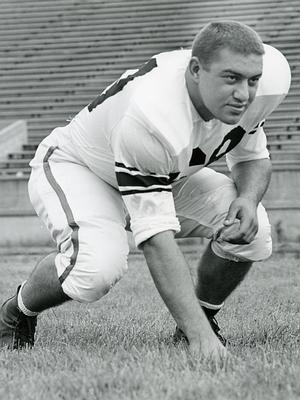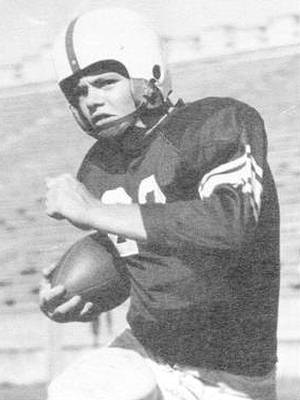

"Helmet Reflections"
HELMET REFLECTIONS FOR OCTOBER 2008
By Dr. Ken
As I write this, another high school football season will begin on Long Island within days. My yearly “clock” is geared specifically to this and with what for me is a “new year” comes a flood of memories of past seasons. Perhaps it truly is a symptom of old or at least, “older” age. Perhaps we all become like our parents as we age and tend to look back, but the start of this football season had me taking a walk down memory lane and thinking about…Kansas State. “Why Kansas State?” is an excellent question. The Helmet News article of December 2005 recalled the great K-State uniforms I witnessed as a collegiate player and referred to their rather hapless history on the gridiron ( http://www.helmethut.com/Dr.Ken26.html ). The many beautiful Kansas State helmets remain a popular feature on the HELMET HUT site (http://www.helmethut.com/College/KansasState/KSUindex.html ). However, my high school and college football experiences were not played out in Kansas so why then, would Kansas State be as prominent in my consciousness as the University Of Cincinnati, local Hofstra University, or the many institutions where I have friends or acquaintances as members of the coaching staffs? Perhaps it’s the Latin phrase that is the state motto of Kansas and that has been adopted by the Wildcats for the 2008 season, as it is that very Latin phrase that is coincidentally, tattooed on my right forearm. “Ad Astra Per Aspera” translates to, “To the stars, through difficulties” or “You’re going to have to overcome a ton of stuff and work your butt off to achieve anything worthwhile,” certainly a lesson I learned a very long time ago. Perhaps it was a conversation with one of my patients who noted that as a teenager, he had a fistfight with one of his high school classmates. The young man he fought was the son of a high school football coach, a wonderful man named Steve Delligatti who decades later became a patient of mine and who had played his collegiate ball at Kansas State. Perhaps it’s the excitement of seeing an underdog rise again, as K-State did years ago when Bill Snyder became the head coach. Kansas State is a fine academic institution. My late father-in-law, a professor and director of research in the School Of Agricultural at Purdue University once told me that Kansas State had one of the best “Ag” programs of study in the nation. Some of the older, historical buildings that grace the campus allow K-State to make the claim that it is in fact, a beautiful school. Unfortunately, at least until the early 1990’s, football success was not among its selling points.
Prior to the arrival of Snyder as head coach in 1989, the “Mildcats” as they were derisively called, had won 299 games to the 510 they had lost. Other than the brief tenure of Bill Meek from 1951 through ’54 and the winning years he enjoyed in his final two seasons, 1936 had marked the last victorious season in Manhattan, Kansas. In what might in retrospect be termed “an error in judgment,” the administration refused to grant a small raise to Meek’s staff after the 1954 season and watched him and his assistants jump to the University Of Houston where he was again successful as he was later at SMU with the quarterback he developed, Don Meredith. K-State then went on to another fifteen years of losing more games than they won in any season. Snyder fixed things and established Kansas State as one of the best programs in the Big 8 and then in the Big 12. Current head coach Ron Prince is, fans hope, on the way to re-establishing the Wildcats as one of the best in the region. With no real ties to the school, I always look forward to Kansas State winning. Steve Delligatti and I would often talk “K-State football” and football as it’s played in various parts of the country. Steve was fortunate to have been recruited out of Uniontown, a typical Western Pennsylvania coal and steel mill town approximately fifty miles southeast of Pittsburgh. Steve was short, stocky, and tough, a perfect interior linemen who could play on both sides of the football.
 |
I know that like many
of us who played in another era,
Steve believed that football taught
him many of the life lessons that
made him a highly respected,
considerate, and well liked
individual, and an area football
coach whose knowledge was constantly
sought. He was the head coach at
Oceanside High School, the primary
rival of Long Beach High School, the
first secondary school I attended.
The very long-running joke in our
house was that once the request was
made that I no longer attend Long
Beach H.S., I was denied the
opportunity to finish at the school
otherwise closest to our town which
was Oceanside. When they refused to
accept me “under any circumstances,”
it added fuel to the already red-hot
fire that came from the inter-school
rivalry. However, having met the
Oceanside head football coach, I
couldn’t bring myself to dislike him
because Mr. Delligatti was that
coach. We had spoken, after it was
assumed that I would enter Oceanside
H.S. and I was extremely impressed
with his demeanor, his soft-spoken
approach, and how welcomed he made
me feel. Steve moved on to coach
Newfield High School in Selden, a
relatively new high school in
Suffolk County. He maintained a
residence in Oceanside where his two
sons were outstanding lacrosse
players, eventually moving on to the
collegiate level where they both
again excelled. One son, Lou, became
well known as a premiere brawler in
the professional lacrosse league.
Steve jumped to the collegiate
level, coaching first at Long
Island’s C.W. Post College and then
handling the offensive line for
Hofstra University when they were
consistently in the Division III
playoffs. Always extremely popular
with his players, and very much a
father figure, Steve provided
guidance both on and off the field
for many under his tutelage.
It is poignant that Steve Delligatti
was on Kansas State teams that were
growing into a successful unit. Like
many if not most of the collegiate
football coaches of the 1950’s and
early 1960’s, head coach Bill Meek
was a former serviceman. The level
of discipline and the physical
demands that each player faced was
infinitely more stringent relative
to today’s player because those
former military men utilized many of
the same core principles as the
foundation of their football
programs. Hard and sometimes harsh
physical training, running, and
drills that might today seem to
border on abuse were standard and in
fact, welcomed by the players
because we knew it would benefit us
during the most crucial points in
any game. The insistence upon
working as a team, displaying mutual
respect, and a higher standard of
daily behavior on and off the field
than that expected of the typical
college student, was a constant and
the backbone of the value system
that each of us carried forward into
“life” once our football playing
days ended. The simplicity of the
white helmet with a purple one-inch
center stripe that Steve wore at
K-State is a reminder of those days,
those values, and the unfortunate
change that today’s game often
reflects.
